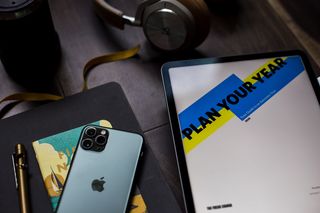Creativity
Build Your Creative Muscle
5 research-based strategies to help you develop and practice creativity.
Posted February 3, 2020 Reviewed by Chloe Williams
Was your New Year’s resolution to be more creative? We enter the New Year with enthusiasm and resolve, but whether it is an attempt at dieting or being more creative, resolutions tend to fizzle as we realize that positive thinking and good intentions alone are not enough to make a change. If you resolved to be more creative, what can you do to make it really happen?

The good news is that creativity is often described as a skill. Creativity scholars can get technical and say that it actually involves abilities, mindsets, personality traits, and self-regulation strategies, as well as a set of conditions in our environments. In one regard creativity is very much like a skill—it takes time to develop, requires effort, and it gets better with practice. The great cello player Pablo Casalas continued practicing into his 80s and was asked in an interview why. He replied that he believed he was getting better. He might have been joking, but not completely.
Here are five research-based tips that can help you build your creativity or help your children or students build their creativity.
1. Play. Find problems.
Notice I did not say play with ideas. I said play. Research by Sandra Russ and her colleagues has shown that imagination in children’s play is related to their creative thinking not only at the same age, but it also predicts creative thinking four and even ten years later. You cannot go back in time and ensure that you play more or more imaginatively, but you can help your children or students have more opportunities for unstructured play that enables imagination.
Adults can play too and do so related to their work. Csikszentmihalyi and Getzels observed art students working on a still life drawing. They were given a large set of objects and asked to include some of them in the drawing. It turned out that students who produced the most creative drawings were those who spent the most time playing with the objects. They arranged them and rearranged them. They handled objects. Weighed them. Felt their texture and shape.
Csikszentmihalyi and Getzels called this process problem finding and considered it the most important aspect of creativity. Creativity comes from open-ended or not well-structured problems, which can be defined or approached in a multitude of ways. Exploring those possible ways can seem like a waste of time in our productivity obsessed culture that wants to account for every moment of our day. But if you want to be creative, resist this popular misconception and take the time to play with possibilities. The result will be more creative than the grit and hard work only approach.
2. Be on the lookout for opportunities and unexpected connections.
Openness to experience is the most fundamental attribute of creative individuals. Openness to experience is a personality trait that describes people who are curious and enjoy exploring new ideas, who are willing to try new and unfamiliar foods and travel to new places, who are interested in beauty in nature and culture, and who are able to consider a wide range of points of view. Personality psychologists have shown that openness to experience is related to creativity in every domain of work, from the arts to technology and sciences and everything in between.
What aspects of openness will be most important depends on your area of work. Openness to a broad range of emotions—both pleasant and unpleasant—and openness to aesthetic experiences are particularly important in the arts, while openness to diverse ideas and intellectual interests are particularly important in the sciences.
People differ in how natural it is for them to be open to new experiences. Do you want to order the same thing at a restaurant every time? Do you go year after year to the same tried and true vacation spot? Maybe openness is not what describes the core of you. But we don’t have to do only what comes naturally. Try something small to break from the routine and you will start opening the doors of openness.
3. Change your perspective.
Psychologists have been developing tests of creative thinking for more than 70 years. These tests ask people to think of as many answers as possible to an open-ended question, such as what are all the possible uses for a tin can or what would happen if people could become invisible at will. But if the instruction changes people’s perspective from asking for as many different answers to asking for creative answers, people tend to give more creative responses. My husband is a master of this technique. Whenever we face a life problem, he explicitly asks how we could approach it creatively. And the perspective changes. To be more creative, challenge yourself to be creative.
Another way to change perspective is to imagine being someone else. Or some time else. Darya Zabelina and Michael Robinson conducted an experiment where they asked one group of college students to describe what they would do if school was cancelled for a day and another group to imagine themselves in the same situation as 7-year-olds. After taking a perspective of a 7-year-old, participants were more original on a test of creative thinking, and this perspective was especially helpful to those who were more introverted and less spontaneous in their everyday lives. What perspectives might be helpful in your own work?
4. Practice creativity skills.
If creativity is (to some extent) a skill, it should be teachable. Indeed, training programs to teach creative thinking have been developed for both children and professional adults. The programs are most successful when they focus on ways of thinking and providing ample opportunities for practice.
In my lab, we created programs to develop creativity by both teaching thinking skills of problem finding and idea generation and by teaching how emotions can be used and managed in the service of creativity. These programs teach that emotions provide different perspectives on problems and that we can learn and employ strategies that can get us unstuck when we face obstacles such as the dreaded writer’s block. After six to eight sessions, both children and adults develop greater creative thinking skills. If you aspire to more creative thinking, make sure to practice it regularly and not only on occasion.
5. Dare to create.
Last, but not least. Creativity requires taking risks. The good news is that creative individuals are not fearless or natural risk-takers. They are more aptly described as tolerating risk and tolerating uncomfortable ambiguity arising when engaged in open-ended problems. What ideas to choose? There is real risk of choosing poorly. As people consider whether to share and pursue their ideas and which ideas, they are asking themselves whether they are willing to stand out.
Daring to create means to be willing to accept occasional discomfort of critical feedback and enduring an occasional thought whether “people will think my idea is silly.” Emotions like these are powerful, but they don’t have to control us. We have agency in relation to our emotions and the ability to manage them. Reminding ourselves that creativity takes some daring will make it more likely for us to do it.
Creativity is complex. There isn’t one thing to do to become creative overnight. It takes time, effort, and practice. Luckily, with decades of research to provide a roadmap.
References
Hoffmann, J. D., Ivcevic, Z., & Maliakkal, N. (in press). Enhancing creativity skills of children enrolled in an emotion rich art-based course. Empirical Studies in the Arts.
Hoffmann, J. D., Ivcevic, Z., & Maliakkal, N. T. (2018). Creative thinking strategies for life: A course for professional adults using art. Journal of Creative Behavior. Advanced online publication.
Kaufman, S. B. (2013). Opening up openness to experience: A four-factor model and relations to creative achievement in the arts and sciences. The Journal of Creative Behavior, 47, 233-255.
Nusbaum, E. C., Silvia, P. J., & Beaty, R. E. (2014). Ready, set, create: What instructing people to “be creative” reveals about the meaning and mechanisms of divergent thinking. Psychology of Aesthetics, Creativity, and the Arts, 8(4), 423–432.
Scott, G., Leritz, L. E., & Mumford, M. D. (2004). The effectiveness of creativity training: A quantitative review. Creativity Research Journal, 16(4), 361-388.
Russ, S. (2014) Pretend play in childhood: Foundation of adult creativity. Washington, DC: American Psychological Association Books.
Zabelina, D. L., & Robinson, M. D. (2010). Child’s play: Facilitating the originality of creative output by a priming manipulation. Psychology of Aesthetics, Creativity, and the Arts, 4(1), 57–65.




